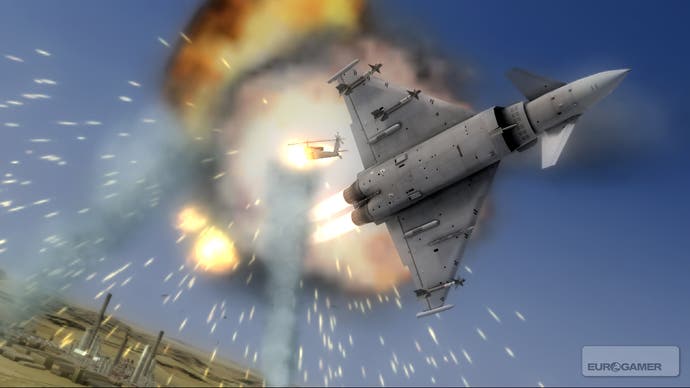Tom Clancy's HAWX
Negative Ghost Rider, the pattern is full.
Game designers love the war on terror, but judging by its output Ubisoft positively salivates at the thought of it. Under the ever-malleable Tom Clancy umbrella, we've waged open-air war in various Ghost Recon titles, engaged in close quarters hostage rescue in Rainbow Six, and snuck around the darkest corners snapping necks in Splinter Cell. Now it's time to rule the skies in the latest addition to the Tom Clancy family, HAWX.
HAWX stands for High Altitude Warfare X (the X meaning 'prototype' and sadly not 'kiss'), and you play as pilot David Crenshaw, an ex-HAWX veteran who rejoins the squadron to restore peace to various parts of the world, including Brazil, the Middle-East and Central Asia [are we still using "restore peace" as a euphemism? - Ed], in the aftermath of a "massive attack" on the USA. A fine excuse, in other words, for engaging in high-speed dogfighting in a collection of technologically advanced aircraft over a series of iconic locations.
In keeping with Ubisoft's desire to create a coherent Tom Clancy 'universe', with overlapping narratives between the various games within it, HAWX kicks off with a reprise of a mission some of you might recall from GRAW 2. "You actually replay the GRAW 2 airstrike mission in Mexico - but from the air," says lead designer Thomas Simon. "When the game starts for real, [it fast-forwards to] 2014 - just after the end of GRAW 2 - and you've joined the private military company in a mission in Africa."
After the African introduction, you and your squadron head to Afghanistan and Rio de Janeiro in Brazil. From there, the aforementioned conflict in the US explodes, and Crenshaw eventually finds himself back on board with HAWX once again, protecting space shuttles over Cape Canaveral. In fact, this part of storyline crosses over with the forthcoming EndWar, another new addition to the Tom Clancy gaming dynasty.

"In EndWar we are announcing some elements of the [HAWX] storyline - and actually more than that - but we can't say everything now. Some titles, like Splinter Cell, have really impressed so much in that they really helped create a whole [Tom Clancy] universe," offers Simon. "With other people from Ubisoft that are working on Clancy titles, now we are able to start playing a bit with the universe itself, creating crossovers. It's getting quite exciting." Okay, so we've got GRAW and EndWar covered off, but what about narrative crossover with Rainbow Six? "Errrr, Rainbow...yes, something like that. You'll see," teases Simon.
As you might expect from a Clancy title, cutting edge, near-future hardware is firmly at the top of the agenda."[We've taken] technology that's already believable and [moved] it one generation further. It's the mature version of what's just a prototype now," Simon says. "So, the ERS (Enhanced Reality System) for some planes that you've seen is in that spirit. And it's not just technology and military authenticity; it features a strong storyline with high stakes. It's also the elite forces, hence the HAWX squadron you're coming from. It has all the ingredients for a Clancy title."
Fortunately for Ubisoft, such claims are given credence when we're allowed to put the opening single-player level through its paces a few times. Two things immediately mark HAWX out as one to watch: the impressively slick 60 frames-per-second game engine and the intuitive controls. "Right from the pre-production stage we wanted 60fps," Simon nods. "And any time we did something to disrupt that, we worked on it until it was fixed. It was very important."

Surprisingly for a flight-combat title, the controls take a matter of seconds to adjust to - but it was all part of the plan, as Simon explains: "We really want the game to be accessible very quickly, so that you immediately feel like you're in control and can have fun killing enemies, or just manoeuvring, and feeling in control. You have a huge possibility to improve yourself - to learn the manouevres, make more flips, and push the plane to the closest possible stall limit and give you more manoeuvrability. This is part of the skill - depth and accessibility at the same time."
But while the general left stick for plane control/right stick for camera control isn't a whole lot different to the classic flight combat games of the past, where HAWX really improves matters is the way it uses an external camera to give you a new and useful perspective. Not only does it give you an idea of your current orientation, but it also locks onto your current target, which proves to be a more useful way of following your enemy than simply chasing an off-screen cursor. Tight turns and flips suddenly become far easier to pull off thanks to this greater degree of visual feedback.
"We worked quite a lot on [the external camera]. It was the most difficult feature that we developed and also the most iterative," Simon admits. "It started by us wanting a way to dodge a missile with a special camera, and we realised we would like to do more stuff with that camera." And in a game where you spend a significant amount of time playing dogfight cat-and-mouse, being able to dodge missiles effectively becomes arguably the crucial gameplay mechanic - both in single and multiplayer.


